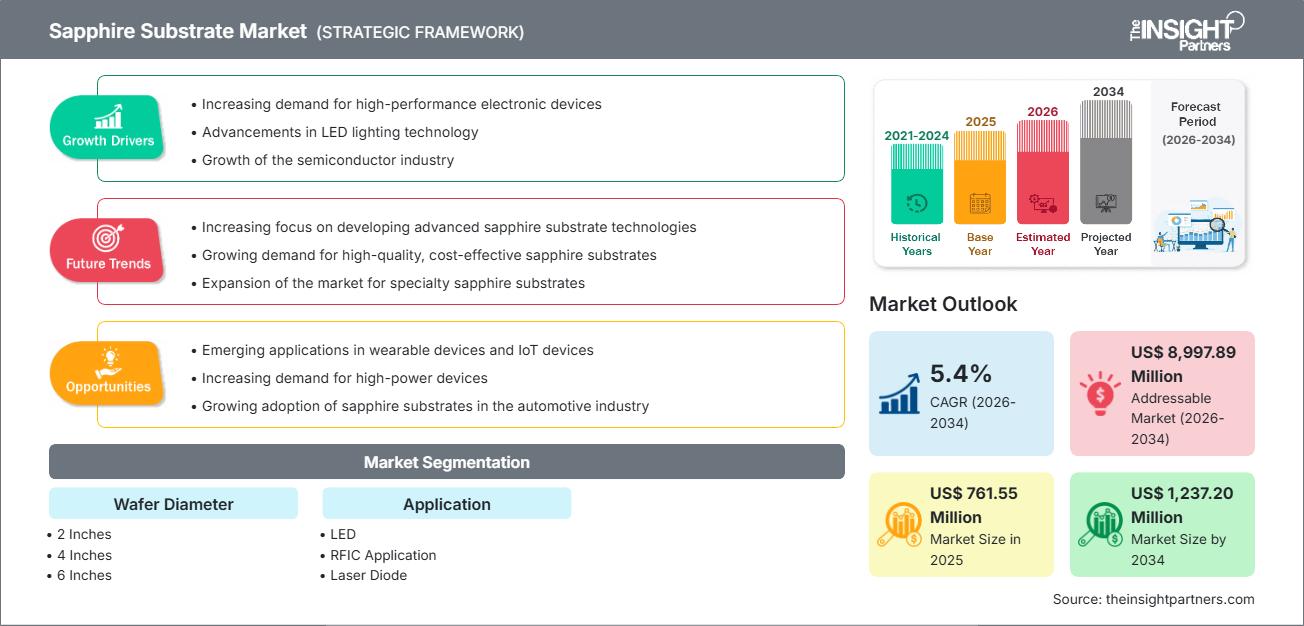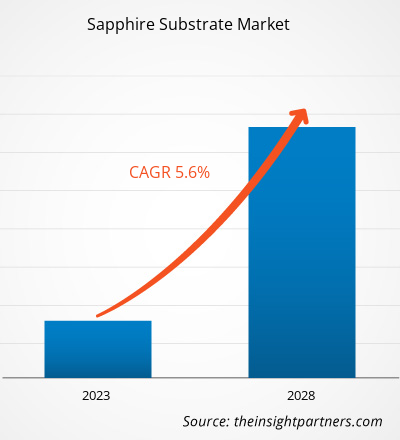Der globale Markt für Saphirsubstrate wird Prognosen zufolge im Jahr 2034 ein Volumen von 1.237,20 Millionen US-Dollar erreichen, gegenüber 761,55 Millionen US-Dollar im Jahr 2025. Dies entspricht einer durchschnittlichen jährlichen Wachstumsrate (CAGR) von 5,4 % im Zeitraum 2026–2034.
Marktanalyse für Saphirsubstrate
Mehrere strukturelle Trends und Verschiebungen in der Endnachfrage untermauern das prognostizierte Wachstum des Saphirsubstratmarktes:
-
Die weltweit zunehmende Verbreitung energieeffizienter Beleuchtungs- und LED-Technologien führt zu einer steigenden Nachfrage nach Saphirsubstraten als Basismaterialien für LED-Wafer und -Bauelemente.
-
Die Expansion der Halbleiter- und optoelektronischen Fertigung, insbesondere für Hochleistungsanwendungen, treibt die Nachfrage nach Substraten aufgrund der überlegenen thermischen, optischen und elektrischen Isolationseigenschaften von Saphir an.
-
Fortschritte bei Kristallwachstums- und Waferherstellungstechniken ermöglichen Saphirwafer mit größerem Durchmesser, was die Ausbeute und Kosteneffizienz verbessert und somit eine breitere Anwendung in verschiedenen Branchen fördert.
- Der Trend zur Miniaturisierung in der Elektronik, der zunehmende Einsatz von Hochfrequenzbauelementen (z. B. HF-ICs, Optoelektronik, Laserdioden) und die steigende Nachfrage in der Automobil- und Telekommunikationsbranche erweitern den adressierbaren Markt zusätzlich.
Marktübersicht für Saphirsubstrate
Saphirsubstrate sind Wafer aus hochreinem, einkristallinem oder polykristallinem Aluminiumoxid (Al₂O₃), die in zahlreichen Anwendungen als Basis dienen, vorwiegend in LEDs, HF-integrierten Schaltungen, Laserdioden, optoelektronischen Bauelementen und Leistungs-/Hochfrequenz-Halbleitern. Dank ihrer exzellenten Wärmeleitfähigkeit, elektrischen Isolation, chemischen Stabilität und optischen Klarheit ermöglichen Saphirsubstrate die Herstellung von leistungsstarken und langlebigen Elektronik- und Beleuchtungskomponenten. Daher sind sie ein wichtiger Bestandteil von Industrien, in denen Zuverlässigkeit gegenüber thermischer Belastung, hohen Frequenzen oder strengen optischen/elektrischen Leistungsanforderungen gefordert sind.
Saphirsubstrate vereinfachen die Geräteherstellung erheblich, verbessern deren Leistungsfähigkeit (z. B. Wärmeableitung, Signalintegrität) und ermöglichen Skalierbarkeit bei zunehmendem Waferdurchmesser und steigender Gerätekomplexität. Das Material dient daher als Basissubstrat für Anwendungen in der Allgemeinbeleuchtung, Unterhaltungselektronik, Telekommunikation, Automobilindustrie und anderen Industriezweigen – von kleinen LEDs bis hin zu hochentwickelten HF-/optischen Bauelementen.
Passen Sie diesen Bericht Ihren Anforderungen an.
Sie erhalten eine kostenlose Anpassung aller Berichte – einschließlich Teilen dieses Berichts, Länderanalysen und Excel-Datenpaketen – sowie attraktive Angebote und Rabatte für Start-ups und Universitäten.
Saphirsubstratmarkt: Strategische Einblicke

-
Ermitteln Sie die wichtigsten Markttrends dieses Berichts.Diese kostenlose Probe beinhaltet eine Datenanalyse, die von Markttrends bis hin zu Schätzungen und Prognosen reicht.
Saphirsubstratmarkt: Treiber und Chancen
Markttreiber
-
Steigende Nachfrage nach LEDs und zunehmende Verbreitung energieeffizienter Beleuchtung: Da LED-Beleuchtung weltweit immer häufiger zum Einsatz kommt, bleiben Saphirsubstrate das Substrat der Wahl für die Herstellung von LED-Wafern.
-
Wachstum der Halbleiter-, optoelektronischen und HF-Industrie: Der Bedarf an leistungsstarken, thermisch stabilen und elektrisch isolierenden Substraten in Halbleiter- und Photonikanwendungen treibt die Nachfrage nach Saphirsubstraten an.
-
Fortschritte bei den Wafer-Herstellungstechniken: Verbesserungen beim Kristallwachstum, die Produktion von Wafern mit größerem Durchmesser und höhere Ausbeuteraten machen Saphirsubstrate für eine Vielzahl von Anwendungen wirtschaftlicher.
- Miniaturisierung und Diversifizierung der Endanwendungen: Die wachsende Nachfrage aus den Bereichen Unterhaltungselektronik, Automobilindustrie (LED-Beleuchtung, Sensoren), Telekommunikation (5G, HF-Geräte) und Industrieelektronik treibt eine breitere Akzeptanz voran.
Marktchancen
-
Zunehmender Einsatz in aufstrebenden Märkten und neuen Branchen: Da die Märkte für Unterhaltungselektronik, Automobilelektronik und erneuerbare/grüne Technologien weltweit expandieren (insbesondere im asiatisch-pazifischen Raum), dürfte die Nachfrage nach Saphirsubstraten erheblich steigen
-
Einsatz in Beleuchtungs- und Displaytechnologien der nächsten Generation: Das Wachstum bei Micro-LEDs, Mini-LEDs und Hochleistungsdisplays schafft eine neue Nachfrage nach hochwertigen Saphirsubstraten.
-
Integration in der Halbleiter- und Photonikindustrie für Hochfrequenz- und Hochleistungsanwendungen: Aufgrund seiner thermischen und elektrischen Eigenschaften eignet sich Saphir ideal für Leistungselektronik, HF/5G-Komponenten, Laserdioden und Optoelektronik.
- Möglichkeit zur Wafergrößenverkleinerung und Kostenoptimierung: Größere Saphirwafer und verbesserte Produktionsausbeuten tragen zur Senkung der Stückkosten bei, wodurch Saphirsubstrate auch für kostensensible Anwendungen wettbewerbsfähig werden.
Markt für Saphirsubstrate, Segmentierungsanalyse
Nach Waferdurchmesser
- 2 Zoll
- 4 Zoll
- 6 Zoll
Nach Anwendung
- LED
- RFIC-Anwendung
- Laserdiode
- Silizium auf Saphir IC
Nach Geografie
-
Nordamerika
-
Europa
-
Asien-Pazifik
- Lateinamerika / Naher Osten & Afrika (LAMEA) / Übrige Welt
Regionale Einblicke in den Markt für Saphirsubstrate
Die regionalen Trends und Einflussfaktoren auf den Markt für Saphirsubstrate im gesamten Prognosezeitraum wurden von den Analysten von The Insight Partners eingehend erläutert. Dieser Abschnitt behandelt außerdem die Marktsegmente und die geografische Verteilung des Saphirsubstratmarktes in Nordamerika, Europa, Asien-Pazifik, dem Nahen Osten und Afrika sowie Süd- und Mittelamerika.
Berichtsumfang zum Markt für Saphirsubstrate
| Berichtsattribute | Details |
|---|---|
| Marktgröße im Jahr 2025 | 761,55 Millionen US-Dollar |
| Marktgröße bis 2034 | 1.237,20 Mio. US-Dollar |
| Globale durchschnittliche jährliche Wachstumsrate (2026–2034) | 5,4 % |
| Historische Daten | 2021–2024 |
| Prognosezeitraum | 2026–2034 |
| Abgedeckte Segmente |
Nach Waferdurchmesser
|
| Abgedeckte Regionen und Länder |
Nordamerika
|
| Marktführer und wichtige Unternehmensprofile |
|
Saphirsubstrat-Marktteilnehmerdichte: Auswirkungen auf die Geschäftsdynamik verstehen
Der Markt für Saphirsubstrate wächst rasant, angetrieben durch die steigende Nachfrage der Endverbraucher. Gründe hierfür sind unter anderem sich wandelnde Verbraucherpräferenzen, technologische Fortschritte und ein wachsendes Bewusstsein für die Vorteile des Produkts. Mit steigender Nachfrage erweitern Unternehmen ihr Angebot, entwickeln innovative Lösungen, um den Kundenbedürfnissen gerecht zu werden, und nutzen neue Trends, was das Marktwachstum zusätzlich beflügelt.

- Verschaffen Sie sich einen Überblick über die wichtigsten Akteure des Saphirsubstratmarktes
Saphirsubstratmarkt, Marktanteilsanalyse nach Regionen
-
Nordamerika: Auch im Jahr 2024 bleibt Nordamerika aufgrund seiner starken Präsenz von Halbleiterherstellern, LED-Firmen und Hightech-Elektronikunternehmen eine führende Region
-
Asien-Pazifik: Es wird erwartet, dass diese Region im Prognosezeitraum die höchste Wachstumsrate verzeichnen wird, dank des Booms in der LED-Herstellung, der zunehmenden Halbleiter- und Unterhaltungselektronikproduktion sowie der steigenden Nachfrage aus dem Automobil- und Telekommunikationssektor, insbesondere in Ländern wie China, Japan, Südkorea und Schwellenländern.
-
Europa: Ein stabiler Markt mit moderatem Wachstum, angetrieben durch die Nachfrage nach energieeffizienter Beleuchtung, grünen Technologien und Halbleiter-/optoelektronischen Anwendungen im Industrie- und Verbraucherbereich.
- LAMEA (Lateinamerika, Naher Osten und Afrika): Stellt ein aufstrebendes Gebiet mit Potenzial dar, insbesondere bei der Einführung von LED-Beleuchtung, erneuerbaren Energien (Solarenergie) und dem Ausbau der Telekommunikation, obwohl die derzeitige Nutzung im Vergleich zu anderen Regionen noch begrenzt ist.
Saphirsubstratmarkt, Marktdichte: Auswirkungen auf die Geschäftsdynamik verstehen
Der Markt für Saphirsubstrate ist nach wie vor fragmentiert bis mäßig konsolidiert. Obwohl einige wenige Schlüsselakteure die globalen Marktführerpositionen dominieren, sind in bestimmten Regionen verschiedene regionale und Nischenanbieter vorherrschend. Dieses Wettbewerbsumfeld beeinflusst strategische Verhaltensweisen wie:
- Senkung der Kosten pro Substrat durch Fokussierung auf die Wafergrößenverkleinerung und Verbesserung der Ausbeuteeffizienz.
- PSS: Differenzierung durch strukturierte Substrate, Spezialsubstrate für High-End-Anwendungen wie HF, Optoelektronik und Photonik.
- Investitionen in Kristallzüchtungs- und Veredelungstechnologien, die ausschließlich Wafer mit höchster Reinheit, geringsten Defekten und großem Durchmesser garantieren.
- Geografische Expansion/Kapazitätserweiterung zur Deckung der Nachfrage in wachstumsstarken Regionen, insbesondere im asiatisch-pazifischen Raum.
Wichtige Unternehmen, die auf dem Markt für Saphirsubstrate tätig sind
- Iljin Display Co. Ltd.
- Kyocera Corporation
- Meller Optics, Inc.
- Monokristall
- Rubicon Technology Inc
- Cryscore Optoelectronic Limited
- Precision Micro-Optics Inc.
- Saint-Gobain SA
- Semiconductor Wafer Inc.
Weitere im Rahmen der Untersuchung analysierte Unternehmen:
- HC SemiTek
- Fujian Jingan Optoelectronics Co., Ltd.
- Yunnan Crystaland Technology Co., Ltd.
- TDG Holding Co., Ltd.
- Gavish
Saphirsubstratmarkt, Neuigkeiten und aktuelle Entwicklungen
-
Laut dem neuesten Bericht von The Insight Partners wird der zunehmende Trend zur Verwendung von LED-Wafern und -Substraten mit großem Durchmesser als ein wichtiger Faktor genannt, der den Markt voraussichtlich ankurbeln wird.
-
Fortschritte in der Fertigung haben dazu geführt, dass mehrere Unternehmen strukturierte Saphirsubstrate (PSS) entwickelt haben, welche die Lichtausbeute verbessern, was insbesondere für Hochleistungs-LEDs und Displaytechnologien der nächsten Generation wichtig ist.
-
Einige führende Substrathersteller investieren in Wafer mit größerem Durchmesser und verbesserte Kristallwachstumsprozesse, um die Nachfrage aus den Bereichen LEDs, Leistungshalbleiter und Telekommunikation zu decken. Dies signalisiert einen strategischen Wandel hin zu Skalierbarkeit und Diversifizierung der Anwendungen.
- Die wachsende Nachfrage aus Sektoren wie der Automobilindustrie (LED-Beleuchtung, Sensoren), der Telekommunikation (5G/RF-Komponenten) und der Optoelektronik erweitert die Endanwendungsbasis über die traditionelle LED-Beleuchtung hinaus und trägt so zur Marktexpansion bei.
Saphirsubstrat-Markt, Berichtsinhalte und Ergebnisse
Der hypothetische Bericht „Saphirsubstratmarkt – Prognose (2021–2034)“ würde Folgendes liefern:
-
Weltweite Marktgröße und Prognose (nach Wert) auf globaler, regionaler und Länderebene für alle wichtigen Marktsegmente (Produkttyp, Anwendung, Endnutzer, Region).
-
Analyse der Marktdynamik: Treiber, Hemmnisse, Wachstumschancen und aktuelle Entwicklungen.
-
Detaillierte Segmentierungsanalyse nach Produkttyp, Anwendung, Endnutzer und geografischer Lage.
-
Wettbewerbsumfeld: Hauptakteure, Marktkonzentration, kleinere regionale oder Nischenanbieter und deren strategische Positionierung.
-
Trends in der Fertigung: Vergrößerung der Wafergröße, Produktionstechnologien, Ertragssteigerungen und die zunehmende Verwendung strukturierter Substrate.
- Prognoseausblick bis 2028 (Basisjahr 2022), einschließlich regionaler Wachstumsraten und neuer Anwendungsgebiete.
- Historische Analyse (2 Jahre), Basisjahr, Prognose (7 Jahre) mit CAGR
- PEST- und SWOT-Analyse
- Marktgröße Wert/Volumen – Global, Regional, Land
- Branchen- und Wettbewerbslandschaft
- Excel-Datensatz
Aktuelle Berichte
Erfahrungsberichte
Grund zum Kauf
- Fundierte Entscheidungsfindung
- Marktdynamik verstehen
- Wettbewerbsanalyse
- Kundeneinblicke
- Marktprognosen
- Risikominimierung
- Strategische Planung
- Investitionsbegründung
- Identifizierung neuer Märkte
- Verbesserung von Marketingstrategien
- Steigerung der Betriebseffizienz
- Anpassung an regulatorische Trends






















 Kostenlose Probe anfordern für - Saphirsubstratmarkt
Kostenlose Probe anfordern für - Saphirsubstratmarkt